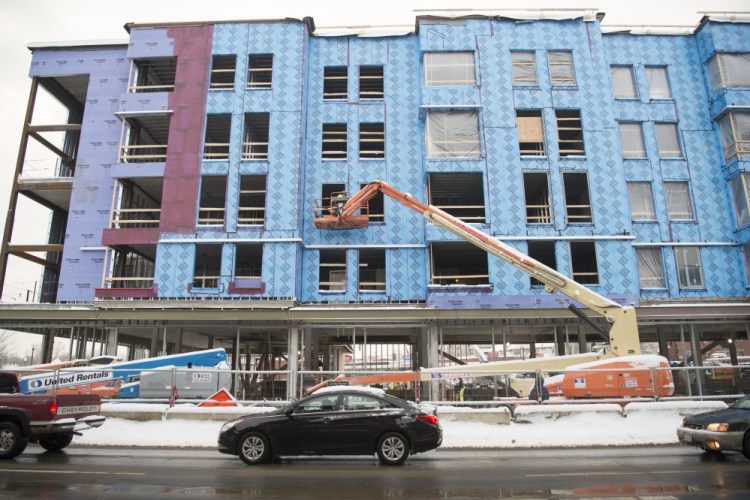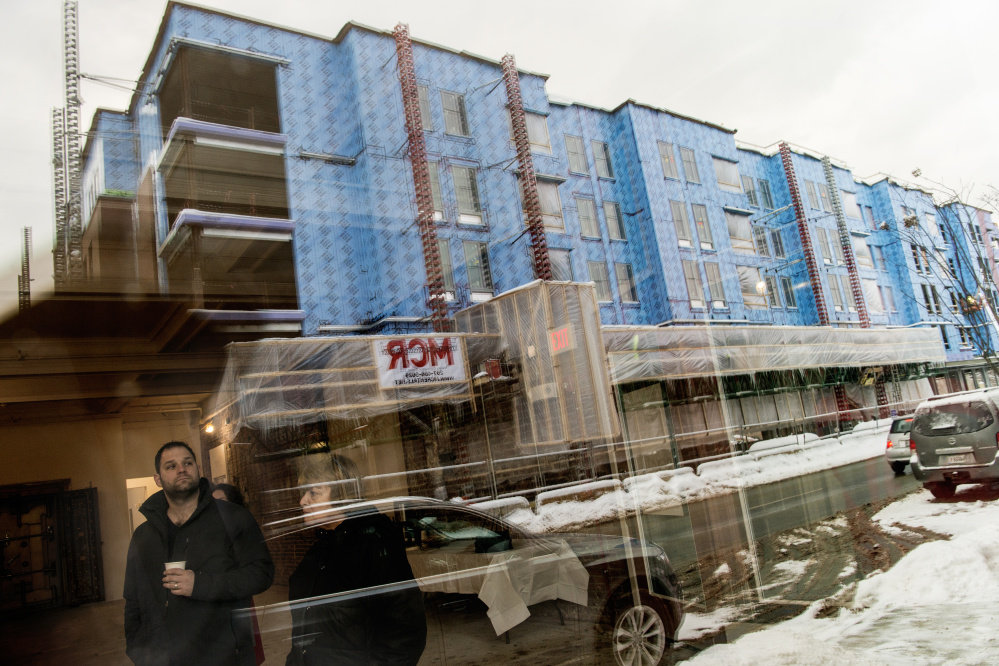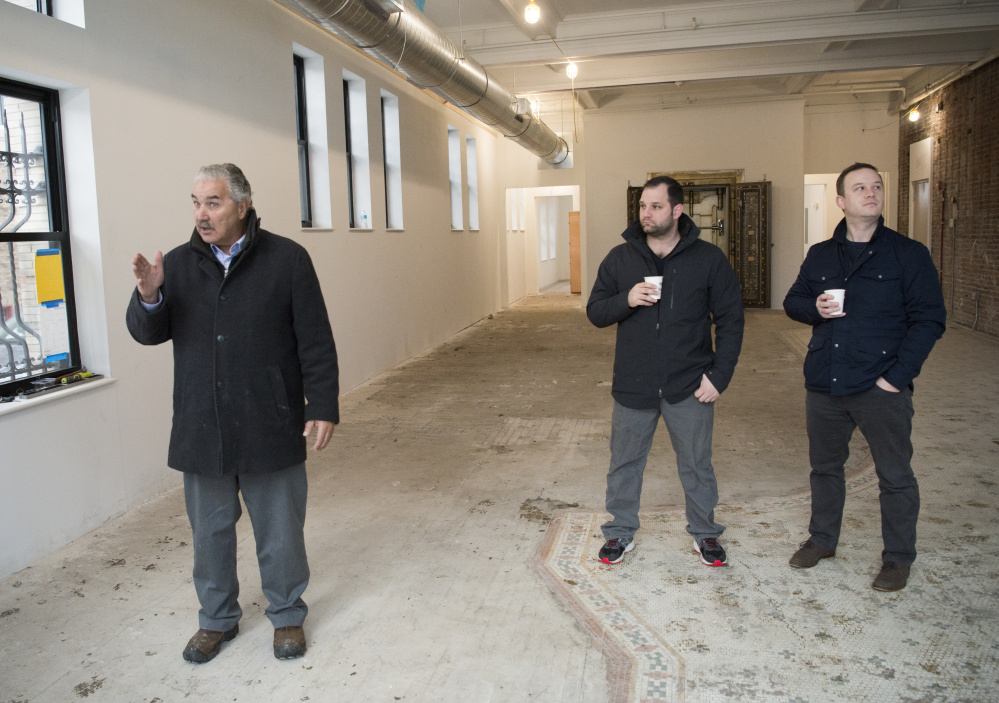WATERVILLE — People often approach Paul Ureneck downtown to ask how construction is progressing on the Colby College mixed-use residential building and what is happening with other Colby projects on Main Street.
“I always get asked questions on the street. ‘What’s going on? How’s the job going?’ ” he said.
Ureneck, director of commercial real estate for Elm City LLC, an affiliate of Colby, tells them things are going well.
“I think we’re making very good progress,” he said. “People say, ‘The building is going up so fast.’ It is going up fast, but it’s also what we need to do to have the building completed by August. It’s on schedule.”
Ureneck was talking Tuesday afternoon to about a dozen people who showed up at 173 Main St., the former Hains building, for an informal update on downtown construction and how it will evolve over the next few months.
In August, the $25 million mixed-use residential building at 150 Main St. will be home to 212 Colby students and faculty members involved in a civic engagement, community-service curriculum. There will be 52 apartments – four one-bedroom units, four two-bedroom and 44 that will be a mix of six- and four-bedroom suites.
The north and southeast corners of the building will be glassed-in on all floors, and a community meeting space on the northeast corner of the first floor may be used by the City Council, the Planning Board and other city groups, as well as nonprofit organizations and social services agencies needing a place to meet.
On the second floor above that room will be a Colby classroom. The third floor will have study space, and the fourth a library.
The community meeting room was something a lot of people said was needed downtown before construction started, and because the students will be engaging with the community, it made sense to have such a space, said Brian Clark, Colby’s vice president of planning. Meetings will be held in full view of people on the street because the room will be glassed-in.
“It will be very visible – very transparent,” Clark said. “There will be a catering kitchen on the first floor as well.”
Clark said he thinks demand for living in the building will be high among students wanting to be part of the program and live in the building. Faculty members for the program are being recruited now. The students will be mostly juniors and seniors with a few sophomores.
“There will be an application process students will have to go through,” Clark said. “There’s a lot of excitement – a lot of interest.”
The main entrance to the building for students and faculty members will be on Appleton Street. Fitness and yoga studios will be in the back of the building.
MILESTONE: DRYWALL NOW GOING UP
Ureneck and Scott Cristina, senior superintendent for Landry French Construction, of Scarborough, and Derek Albert, project manager for Landry French, said masonry work is complete on the Appleton Street side of the building and it will start soon on the front or Main Street side. It will proceed to the rear of the building after that and the Temple Street side will be done last.
“There are 22 masons on the job,” Ureneck said. “There will be 22 people laying brick or assisting.”
He said plumbing work is ongoing in the building, as well as duct work and electrical wiring.
“Today was a big milestone because they started hanging interior drywall, and tapers came onto the job today and put mud on the walls, so that’s huge,” Ureneck said.
In early January, a crane will come in to move to the roof some equipment that includes cooling towers, boilers and major pieces of mechanical equipment, said Ureneck and Cristina.
“The elevators will be showing up mid-January,” Cristina said.
Ureneck said he does not foresee any extended road shutdowns around the site from now on.
Albert said local businesses and agencies have been patient and understanding when necessary interruptions have occurred.
“We can plan and plan and plan, but there’s always going to be an oddball delivery,” he said.
MARKETING RETAIL SPACE
The first floor of 150 Main St. spans 7,800 square feet and can be subdivided into up to five retail spaces to be leased out, Ureneck said. Retailers vary in what they want: Some like 1,500 square feet or less, and others 40,000 square feet or more, he said.
“Potentially, it could be one tenant,” he said of the ground floor space.
About a month ago he and others sat down and started getting serious about marketing that space, he said. Tenants want to be able to see the actual space before they sign on, and with construction progressing, they will be able to do so.
“It’s always good to have a product to show and not just be sending out pictures of a building,” Ureneck said.
As for 173 Main St., which has two retail spaces available on the ground floor – each about 2,500 square feet – Ureneck and Clark said officials are close to signing a tenant for the southernmost space to the right of the main entrance. Without revealing too much, Clark said it is a food and beverage business.
Employees of CGI Group, a technology business now housed temporarily at Hathaway Creative Center, are planning to move to the third floor in mid-January, and as more people are hired, they plan to move into the fourth floor as well, Clark said.
Fifteen to 20 Colby employees now work on the second floor, including museum curators and research and development staff.
“They love it, particularly the ones who have the Main Street windows,” Clark said.
Colby plans to build a boutique hotel starting next year at the former Levine’s clothing store site at the south end of downtown and is considering plans for the former Waterville Hardware building across the street.
“We’re working through the concept design right now,” Clark said of the hotel.
Nothing is set in concrete about the Waterville Hardware space across the street, although a mixed use of residential and commercial has been discussed, he said.
“We’re going to pause and re-test the market,” he said.
Waterville resident Bill Basford asked if there is any chance the hotel could be a timber-framed building.
Ureneck said the idea has been kicked around.
“We haven’t made any of those decisions yet,” he said, noting that Basford had expressed such interest in the past. “It’s becoming more and more an accepted methodology of construction.”
Basford said timber-framed buildings will become more and more popular. “It will happen sooner or later. I’d like to see it sooner,” he said.
Mayor Nick Isgro, Colby President David Greene, city officials, downtown business advocates and those involved in the arts met several times before downtown revitalization work started to explore ways to help improve the downtown, draw more people there, help support and enhance existing business and arts organizations, and help boost economic development.
Priorities they identified to help make improvements included addressing vacant and dilapidated buildings. Colby bought and renovated 173 Main, bought and tore down the Levine’s building and bought and demolished the former Elks building on Appleton Street. That space is now a parking lot.
Colby plans to infuse about $60 million into downtown revitalization.
CHANGE IN TRAFFIC PATTERNS
Meanwhile, the City Council voted 7-0 on Sept. 5 to support an estimated $4.4 million change in downtown traffic patterns that would make Main and Front streets two-way and include significant changes to intersections downtown.
Isgro and City Manager Michael Roy emphasized that the vote does not mean two-way traffic will be instituted; it merely allows the city to pursue funding from the state and federal governments, as well as private funding, to make the change.
Roy said public meetings would be held before the start of any construction to allow public input.
During discussions held in the city over the last year and a half about downtown revitalization, those who supported two-way traffic on Front and Main streets said the change would help to slow traffic; make the area safer for drivers, pedestrians and bicyclists; and encourage people to stop, shop, eat and recreate downtown.
Kimberly N. Lindlof, executive director of the Central Maine Growth Council, attended Ureneck’s gathering Tuesday and said she is impressed with the construction projects.
“I think it’s incredible the progress that they’ve made in such a short period of time,” Lindlof said.
She said she looks forward to having Colby students downtown.
“Having activity down here is going to be such a breath of fresh air,” she said. “Once people are living down here, we will have traffic calming because people will be interacting, crossing the street, going to the library, volunteering at businesses. Our downtown is going to be vibrant and active.”
Bobby McGee, owner of Selah Tea, across Appleton Street from 173 Main, said he thinks the Colby efforts are “awesome.”
He said he stays in close contact with Ureneck and other officials and for the most part has not had problems with parking, which was a concern that many people expressed before construction started.
Colby employees at 173 Main St. frequent Selah Tea, and often customers will sit by the windows to watch the construction across the street, said McGee, who noted that he also looks forward to having students living downtown.
Send questions/comments to the editors.






Success. Please wait for the page to reload. If the page does not reload within 5 seconds, please refresh the page.
Enter your email and password to access comments.
Hi, to comment on stories you must . This profile is in addition to your subscription and website login.
Already have a commenting profile? .
Invalid username/password.
Please check your email to confirm and complete your registration.
Only subscribers are eligible to post comments. Please subscribe or login first for digital access. Here’s why.
Use the form below to reset your password. When you've submitted your account email, we will send an email with a reset code.